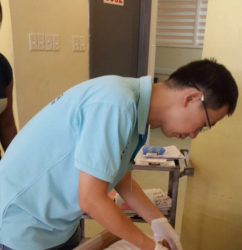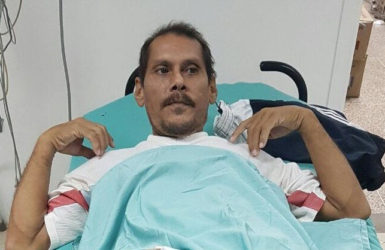A resident of Region Nine who had successful surgery to remove a malignant type of skin cancer from his leg, is grateful to Dr Wan Neng of the 12th Chinese Medical Brigade (CMB) for getting rid of the dreaded disease and preventing it from spreading to the rest of his body.
The man, Colin (only name given), did not mind one bit that becoming cancer-free meant his leg being amputated in the process.
He had sustained a wound to the back of his right leg when he was involved in a traffic accident a few years ago. He sought treatment continuously at the Lethem Hospital, but instead of healing, the wound became worse.
Colin then journeyed to the Georgetown Public Hospital Corporation (GPHC) where he consulted with Dr Wan, and surgery was subsequently arranged.

He felt the surgery would not have been possible had it not been for the initial diagnosis of Dr Syed Ghazi who had visited the hospital while on a cancer screening and awareness exercise at Lethem.
The doctors there had asked Dr Ghazi, Director of Outreach at the Cancer Institute of Guyana to examine the wound. Based on suspicion that the wound had become cancerous, Dr Ghazi advised Colin to visit the GPHC for confirmation and treatment.
Dr Wan told Stabroek News that he examined the wound, which measured “25 cm by 15 cm across from thigh to shank, carefully with my colleagues” and documented the man’s medical history.
He pointed out that “before the operation, we took three pieces of tissues to pathology.” The biopsy “confirmed that it was a squamous carcinoma – a kind of malignant skin cancer which is caused by long-term infection. It can easily be metastasized to other organs and lead to death.”

He explained that squamous cell carcinomas are a relatively slow growing type of skin cancer. However, some forms are aggressive and can spread to other parts of the body, including fat tissues, lymph nodes, and internal organs.
Dr Wan said all of the pre-operation tests showed that Colin’s right side lymph nodes were bigger than the regular size.
This was not a good sign “because the main path of the metastasis is the lymph system. So no matter what operation plan we chose, inguinal lymph node dissection was necessary.”
He added, “Considering the patient’s long-term survival rate, I chose amputation” because the defect could not be corrected.
On October 16, Dr Wan and team successfully completed the amputation of the leg and inguinal lymph node dissection.
He explained that during the surgery, he separated the femoral artery, veins and femoral nerve and each branch and removed all tissues needed. The procedure took two and half hours and Colin only lost about 100 ml of blood.
Dr Wan recalled that the local doctors had told him that it was “dangerous to dissect this region; they had never done the surgery before. But I told them don’t worry.”
He was pleased that “all went well as expected” and that he was able to prevent the cancer from spreading to the rest of Colin’s body.
But it was bittersweet for Colin, who told Stabroek News via telephone that while he was sad at first about losing his leg, he was happy that he was out of danger and that the wound was no longer there to cause him discomfort.
He was also grateful that he is able to carry out his normal chores again. But he did not want to say too much on the phone though because he “preferred to speak in person.”
Dr Wan said that on the “first day of post-operation the incision was great, the drainage tube was clear and the operative area was normal.”
He recalled that when he made his round in the ward, he told Colin that he should wait on the biopsy of the lymph nodes. If the biopsy was positive, Colin would have needed to undergo radiotherapy.
Fortunately, it came back negative and Colin was free to go back to his community and continue his normal life. But he is required to visit every six months for check-ups to ensure he is still safe.
Dr Wan said Colin left the hospital quite satisfied and expressed appreciation to him for the good job he had done.
The 12th CMB, headed by Dr Chen Lianhua, comprises a team of 16 doctors who arrived here in June. They are expected to depart Guyana by May this year.
They are offering their services at the GPHC and the Linden Hospital Complex in obstetrics and gynaecology, anaesthesiology, general surgery, ophthalmology, burn and plastic surgery, orthopaedics, radiology, acupuncture, nephrology, pathology, and paediatrics.
Their visit here is part of efforts to preserve the bilateral relations between the Government of Guyana and the People’s Republic of China.
The first batch of Chinese medical professionals came to Guyana on May 26, 1993, as a result of the Protocol on Medical Cooperation signed between the two countries.




